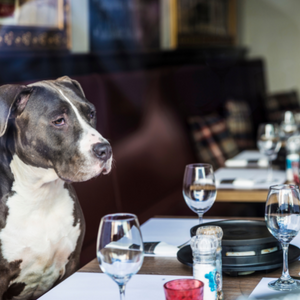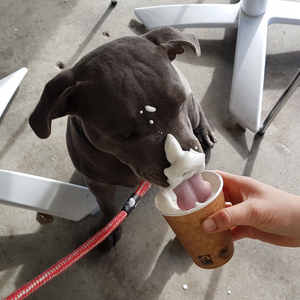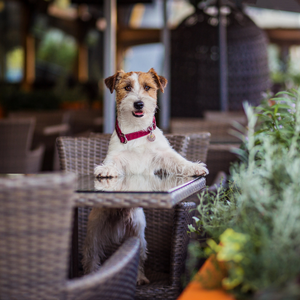Dogs are a man's best friend, so why not reserve a seat for them at your restaurant? Many restaurants have expanded on their outdoor dining options due to the COVID-19 pandemic in order to follow social distancing procedures. Simultaneously, people have gotten more attached to their fur-babies because of all the time they spent together at home. Although we are somewhat back to normal, pet owners are struggling to leave their pups behind.
Establishing a pet-friendly environment at your restaurant attracts more customers and increases your net profit. Our guide to creating a dog menu features all of the information you need to provide your furry patrons with a pawsome dining experience.
Why Should You Add Items For Dogs On The Menu?
Who doesn't want more customers in their restaurant? Expanding your establishment's menu to feature food for dogs allows you to attract a unique customer base. There are three reasons why many restaurateurs are finding it beneficial to create a menu for their four-legged guests:
- Appeals to the pet owners: By adding a dog menu, establishments are appealing to the pet owners which make up 44% of households in the U.S., according to the ASPCA. Dog menus help restaurants expand their target audience and improve the dining experience for customers who enjoy having pups nearby.
- Increases foot traffic: A pet-friendly restaurant can attract people walking by to stop and get to know the dogs. It also helps bring in people walking their dogs and find a welcoming environment to stop and grab a drink or snack.
-
Boosts opportunity for sales: Guests will order these
dog-specific items, which adds to their bill. Creating a pet-friendly
space allows you to advertise to a larger audience and helps increase
your net profit.

What Foods Can Dogs Not Eat?
Dogs have sensitive stomachs and delicate health, making it important to be careful what you feed them. Below are some ingredients that you should steer clear of when creating menu items for dogs:
- Onions, garlic, and chives can cause gastrointestinal irritation and damage red blood cells.
- Macadamia nuts affect a dog's nervous system resulting in weakness, panting, and swollen limbs.
- Corn on the cob can cause blockage in the intestine and while the corn itself is okay for dogs to eat, some may have trouble digesting it.
- Avocados have a substance called persin which can cause diarrhea and vomiting for dogs.
- Artificial sweeteners (Xylitol) may cause hypoglycemia which is linked to blood clotting disorders and liver failure.
- Chocolates contain the stimulant theobromine which can cause kidney failure.
- Grapes and raisins can cause liver damage and kidney failure.
What Foods Are Okay For Dogs To Eat?
When coordinating your food items for dogs, it's important to consider their palette and health. Here is a list of ingredients you can incorporate into meals to create a doggy-safe menu:
- Bread
- Quinoa
- Rice
- Plain yogurt
- Fully cooked eggs
- Turkey
- Pork
- Fish
- Coconut
- Blueberries
- Oranges
- Peaches
- Pears
- Pineapple
- Raspberries
- Strawberries
- Watermelon
- Carrots
- Celery
- Green beans
- Honey
- Peanut butter
Menu Item Ideas For Dogs
 Your dog patrons may not be expecting a 4-course meal
but having some variety on the menu highlights how welcoming your
establishment is for them. Whether the pup diners are visiting for
breakfast, lunch, dinner, or maybe just a sweet treat, build a menu that
caters to their likings (just like you would to their owners). Here are
some menu ideas for dogs you can include at your restaurant:
Your dog patrons may not be expecting a 4-course meal
but having some variety on the menu highlights how welcoming your
establishment is for them. Whether the pup diners are visiting for
breakfast, lunch, dinner, or maybe just a sweet treat, build a menu that
caters to their likings (just like you would to their owners). Here are
some menu ideas for dogs you can include at your restaurant:
- Scrambled eggs and turkey
- Yogurt parfait with blueberries, peaches, and pears
- Quinoa bowl with choice of (unseasoned) protein
- Rice with veggies (carrots, celery, green beans) and choice of (unseasoned) protein
- Fruit salad drizzled with honey (strawberries, watermelon, pineapple, oranges, raspberries)
- Coconut milk peanut butter ice cream
Important Tips When Cooking For Dogs
There are specific ways that you should cook food for dogs to prevent them from getting sick. Keep these few tips in mind when preparing meals for dogs:
- Leave ingredients unseasoned to avoid any added salt that can be detrimental to dogs.
- Limit the amount of sugar in dog meals since they are sensitive to sugary substances.
- Cook with coconut or olive oil to avoid other oils with high levels of saturated fats like butter.
- Refrain from serving dog meals too hot, which could burn the pup's mouth or upset their stomach.
- Limit the amount of dairy you use when making food for dogs because some have difficulty digesting dairy.
Cons Of Adding A Dog Menu
Just like how having a dog is a big responsibility, so is having a dog-friendly establishment. There are a few things to consider before welcoming furry guests.
Unwanted Guests
Dining beside dogs may not be part of an ideal night out for individuals allergic to dogs or just aren't very fond of them. Those customers who don't share the same sentiment for dogs as pet owners may be dissuaded from dining at a pet-friendly restaurant.
Clamor & Commotion
Not all dogs behave the same way. While some might be very quiet and well-kept during their dining experience, others may be excited or agitated from the outing, especially if other dogs are around. Dogs might also bark while at the restaurant, which many patrons don't want to hear while eating. The additional noise source may not allow guests to hear their servers or own parties.
Extra Cleanliness
Although we can clean up after ourselves, our furry friends can't. Having a pet-friendly establishment takes some extra upkeep. In order to maintain cleanliness, a more thorough cleaning process may have to be put into place to keep your restaurant and employees up to standards.
- Restaurant cleaning: Being a dog-friendly business may add more steps to the usual post-shift cleanup, like washing extra dishes and meticulously sweeping the designated doggy area. It's recommended to wash dog bowls separately from typical dishes to avoid cross-contamination of any bacteria. Spaces reserved for customers and their dogs should also be regularly swept and mopped in case of any doggy accidents or general messes made while eating.
- Employee hand washing: Even while working, your employees are tempted to admire the guest pups and show them some love. While this may be fine with the dog owners, it's essential to keep in mind that they are still handling food. Hand washing between petting the dogs and serving customers' food is vital in maintaining a clean and safe dining environment.
Where Should Dogs Be Seated?
While some restaurants may allow furry friends to dine inside among the
human guests, others with an outdoor patio area typically reserve that
space for pet owners and their companions. Separating a certain area for
pet owners and their pets, whether inside or outside, allows for proper
distance from allergic guests who don't want to eat next to animals.
Reserving an outdoor patio space may be easier to clean and maintain for
a dog-friendly restaurant, but it's essential to keep an alternative in
mind for the colder and hotter seasons. No matter which option you
implement, your doggy diners are sure to appreciate it.
What Places Already Have A Secret Pup Menu?
From dine-in burger restaurants to drive-thru ice cream shops, draw some inspiration from establishments that have already set up a dog section to their menus across the country. Here is a list of popular restaurants that feature a menu for dogs:
- Starbucks "Puppuccino"
- In-N-Out Burger "Pup Patty"
- Dairy Queen "Pup Cup"
- Tim Horton's "Doggy Timbit"
- Culver's "Pup Custard"
- Johnny Rockets "Dog Burger"
- Shake Shack "Pooch-ini" and "Bag o' Bones"
- Sprinkles "Pupcakes"
Stay Together, Dine Together
While your doggy guests may be easier to please than your human ones, it doesn't make them any less important. Creating an appropriate doggy menu is beneficial as families are able to bring their furry friends along and everyone gets to enjoy a plate. A successful pup menu will expand your customer audience, improve customer experience, bring in more revenue, and get you many tail wags.






